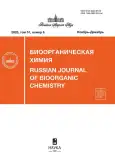Russian Journal of Bioorganic Chemistry
The Journal was founded in 1975 by Prof. Yurii A. Ovchinnikov. The Editorial Board uses the term "bioorganic chemistry" to cover a wide range of problems related to the investigation of the structure and function of biomolecules using the methods of organic, biochemical and physical chemistry.
The journal is intended for scientists, for those in the health professions, educators, and students in universities and researchers in industrial, medical, agricultural, and environmental control laboratories.
Russian Journal of Bioorganic Chemistry (Bioorganicheskaya Khimiya) welcomes papers on all aspects of bioorganic chemistry, biochemistry, cell and molecular biology, genomics, proteomics, bioinformatics, immunology, molecular virology, molecular evolution and developmental biology.
The Journal publishes reviews, minireviews, research articles and theoretical investigations, hypothesis and short communications.
The Journal is published in Russian (under the name Bioorganicheskaya Khimiya in the Russian Federation) and in English (under the name Russian Journal
of Bioorganic Chemistry) six times a year by Russian Academy of Sciences (IKC "Akademkniga") in Moscow (Russia) and Pleiades Publishing Inc. in the United States. The English edition is distributed worldwide by Springer.
Articles are published in Russian and English. Publication of articles in the Russian Journal of Bioorganic Chemistry (Bioorganicheskaya Khimiya) – free.
Media registration certificate: № 0110214 от 08.02.1993
Current Issue
Vol 51, No 6 (2025)
ОБЗОРНЫЕ СТАТЬИ
Clinically Significant Panallergens in Development Sensitization and Methods of Their Diagnosis
Abstract
 1011-1026
1011-1026


ЭКСПЕРИМЕНТАЛЬНЫЕ СТАТЬИ
Assessment of Adaptive Immune Response Against Influenza Using Synthetic Peptides
Abstract
 1027-1037
1027-1037


Mono- and Dihydrazones with a 6-Methyluracil Fragment: Synthesis, Cytotoxicity, and Antioxidant Activity
Abstract
 1038-1050
1038-1050


Features of Synthesis and Study of Toxic Properties of Tryptophan-Containing Analogue of Arginine-Vasopressin
Abstract
 1051-1062
1051-1062


Spatial Structure of the C-Terminal Domain of Bacillus cereus Hemolysin II is Stabilized in the Composition of the Full-Size Toxin
Abstract
 1063-1074
1063-1074


New Conjugates of 3'-Azido-3'-deoxythymidine and 2',3'-Dideoxy-3'-thiacytidine Based on 1,3-(Dipalmitoylamino)-propan-2-ol: Synthesis and Investigation of Anti-Hiv Activity on Model Cellular Systems
Abstract
 1075-1087
1075-1087


Three-Dimensional Structure of the Orange-Red Fluorescent Biomarker DiB3-F53L
Abstract
 1088-1092
1088-1092


Determination of IgG and IgA Antibodies by Fluorescence Polarization Using Fluorescently Labeled Recombinant Nanobodies
Abstract
 1093-1105
1093-1105


Synthesis and Biological Properties of Pyridoxine Derivatives Containing 1,3-Oxazolidine-2-one Fragments
Abstract
 1106-1132
1106-1132


Synthesis and Antibacterial Activity of Ethynyl and Azido Derivatives of N4-Dodecylamino-2'-deoxycytidine
Abstract
 1133-1141
1133-1141


N4-(ω-Aminoalkyl)- and N4-(ω-Dansylaminoalkyl)-5-methyl-2'-deoxycytidines
Abstract
 1142-1147
1142-1147


Composite Aerogel Materials with Hemostatic Effect Based on Alginate and Chitosan
Abstract
 1148-1158
1148-1158


Assessment of Toxicity, Genotoxicity, and Cytotoxicity of Phenycycloalkanpolycarboxylic Acids: A Study with Allium cepa and Chlorella vulgaris
Abstract
 1159-1166
1159-1166


Analysis of the Protein-Protein Interaction of CREBBP, HTT, and KMT2D by Principal Components Method
Abstract
 1167-1174
1167-1174


ПИСЬМА РЕДАКТОРУ
Kaede Protein Chromophore Analogue as a Tool for Simultaneous Selective Staining of the Nucleus and Mitochondria
Abstract
 1175-1180
1175-1180












